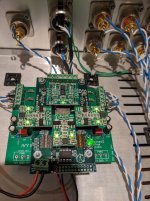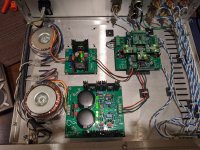I had posted this in the Twisted Pear forums but seeing as the last half dozen or so threads had no replies thought I would post it here. I have a Buffalo III SE which is no longer locking onto a signal. The only input on it currently is the spdif, the mute led comes on, lock led does not. Have tried multiple sources which have a spdif out. Any troubleshooting suggestions would be greatly appreciated. Here are some readings I'm getting on my multimeter.
The readings which were inconsistent were those going to the IVY. Readings were 1.4V except for G-Negative on the left side was 0V.
5.2V at the input terminal from placid power supply.
Trident on left side of Buffalo
G-IN - 5.2V
G-OUT - 3.28V
Trident in the center
G-IN - 5.2V
G-OUT - 3.26
Trident on the right
G-IN - 5.2V
G-OUT - 1.17
AVCC
G-IN - 5.2V
G-OUT - 3.6V
G-NC - 3.27V
These readings match on both sides of this module.
Connections to IVY-III
G-Positive - 1.41V
G-Negative - 1.41V
ON left side (next to "Russ White" writing)
G-Positive - 1.41V
G-Negative - 0V
The readings which were inconsistent were those going to the IVY. Readings were 1.4V except for G-Negative on the left side was 0V.
5.2V at the input terminal from placid power supply.
Trident on left side of Buffalo
G-IN - 5.2V
G-OUT - 3.28V
Trident in the center
G-IN - 5.2V
G-OUT - 3.26
Trident on the right
G-IN - 5.2V
G-OUT - 1.17
AVCC
G-IN - 5.2V
G-OUT - 3.6V
G-NC - 3.27V
These readings match on both sides of this module.
Connections to IVY-III
G-Positive - 1.41V
G-Negative - 1.41V
ON left side (next to "Russ White" writing)
G-Positive - 1.41V
G-Negative - 0V
Attachments
I don't have a scope. I can install pins and connect jumpers to perform any of the functions that would be done using ext io or gpio.
Not sure what good ext io and or gpio will do in this case. May I ask a little more about the Buffalo dac? How old is it, any problems before, how do you like the sound, how long do you expect to keep it, etc..?
It's about 3-4 years old. No issues prior. I like the sound fine. Not attached to it either way. The rest is all the there, power supplies, ivy output stage.. for that reason would like to get it working again.
Okay. Only way I know to see if SPDIF signals are making it to the dac chip is with a scope. However, you can check all the dac chip and the SPDIF interface circuity voltage regulators with a DVM. Another thing that can be done without a scope is to take a magnifying glass and carefully inspect small SMD components, especially ceramic caps, for hairline cracks, check solder joints for cracks, check all connectors for good connections, check electrolytic caps for any sign of bulging, etc.
Beyond that, lock status is indicated in an I2S bus register inside the dac chip. An MCU can poll that register to see if lock is established. Its possible to attach an Arduino or similar MCU to manually access the dac chip control registers and see what the status is and if the registers are correctly configured. How to do that I could explain, it can be a little bit of a project. Sometimes some tiny soldering may be required to do it, but it is doable. Probably I would try a scope before that.
Now regarding a scope (which are arguably not optional for even moderately serious diyaudio, you need one to play this game), there are some low cost used ones on ebay. What clock frequencies are you running, 100MHz? Something less? IIRC SPDIF can run at a few or several MHz but its much less than 100Mhz. Cheapy $20, 1MHz scopes wouldn't be of much use.
Beyond that, lock status is indicated in an I2S bus register inside the dac chip. An MCU can poll that register to see if lock is established. Its possible to attach an Arduino or similar MCU to manually access the dac chip control registers and see what the status is and if the registers are correctly configured. How to do that I could explain, it can be a little bit of a project. Sometimes some tiny soldering may be required to do it, but it is doable. Probably I would try a scope before that.
Now regarding a scope (which are arguably not optional for even moderately serious diyaudio, you need one to play this game), there are some low cost used ones on ebay. What clock frequencies are you running, 100MHz? Something less? IIRC SPDIF can run at a few or several MHz but its much less than 100Mhz. Cheapy $20, 1MHz scopes wouldn't be of much use.
I was hoping there was some odd way I could trigger a reset for the DAC and hopefully that takes care of it. But indeed if there is an underlying issue than that wouldn't do much. I can check the physical stuff, check connections, and get readings. But lot of the other stuff is a bit over my head. I have played around with changing filters on my soekris dac, but that was fairly straightforward to interface with that using a serial cable. I do appreciate the tips, might start with the physical stuff.
Perhaps the SPDIF input circuitry that precedes the DAC has failed. If you can map out the path from the SPDIF input to the relevant pin on the ESS chip you the check continuity running a wire from the ESS pin to the input of another SPDIF capable device. Alternatively, you can seek to isolate the SPDIF input pin on the chip and connect a known good SPDIF signal from another board.
Was there any change in the S/PDIF source? The manual notes "So the Buffalo III only supports TTL level S/PDIF next
to the usual I2S and DSD signals. Unless your source explicitly states it outputs TTL level S/PDIF you
should asume it’s output is consumer level S/PDIF. For consumer level S/PDIF a comparator or other
type of conversion is needed."
to the usual I2S and DSD signals. Unless your source explicitly states it outputs TTL level S/PDIF you
should asume it’s output is consumer level S/PDIF. For consumer level S/PDIF a comparator or other
type of conversion is needed."
This unit has been sitting powered off for some time, I remember it working with two devices outputting SPDIF but maybe it's my memory that is faulty. I will see if I can get my hands on a device that outputs TTL level SPDIF. Thanks for the tip.
Finally got around to trying a different spdif source from my opus dac. One was a spdif/coax connector, other was from optical to spdif board outputs. Both working fine with opus. Still no luck.
Any thoughts on if this might be the trident on the right? It is outputting 1.17V, is this too low?
Any thoughts on if this might be the trident on the right? It is outputting 1.17V, is this too low?
- Home
- Source & Line
- Digital Source
- Buffalo III SE S/PDIF won't lock

